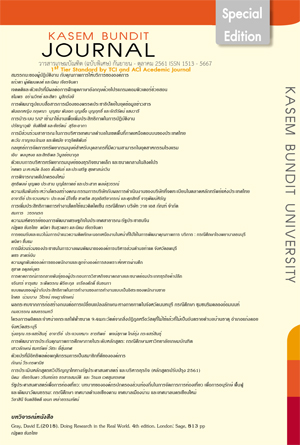Attitude Toward and Variables Affecting English Speaking Practice Through Computer- Assisted Instruction
Keywords:
Computer Assisted Instruction Program, attitudes, English speaking trainingAbstract
This research investingated a group of 41 the Mattayom 6 students at Hatyairatprachasan School in a Computer Assisted Instruction Program. The results were as follow: The students’ attitude toward practicing speaking English via Computer Assisted Instruction Program was favorable at a high level (=4.13 out of 5.00) ; the variables affecting practicing speaking English through Computer-Assisted Instruction was the speaking English content in the Computer Assisted Instruction Program (=4.49 out of 5.00).
References
Benson, P. (2007). Autonomy in language teaching and learning. State of the art article language Teaching, 40(1), 21-40.
Berrett, D. (2012). How ‘flipping’ the classroom can improve the traditional lecture. The Chronicle of Higher Education
Bloom, B.S. (1976). Human Characteristics and School Learning. New York: McGraw Hill.
Brown, H.D. (2005). Teaching by principles and interactive approach to language pedagogy.New Jersey. Prentice Hall Regents.
Carter, R.Numan,D.(2013). The set of development L2 skill. U.K: Cambridge University Press.
Chiramanee, N. (2007). Intensive Teaching Listening and Speaking toward Sudents’ Language Ability : A Case Study of Thidanukro School, Hatyai, Songkhla : The Thailand Research Fund.
Gardner, R.C.& Lambert, W.E.(1972). Motivation Variables in Second Language Acquisition. In Attitude and Motivation in Second Language Learning.266-272. Massachusetts: Newsberry House, 1972.
Genesee, F.(2000.) Brain research: implications for second language learning. Eric Digest, December.Retrieved on June 1, 2003.
Kukulska-Hulme, A., & Shield, L. (2008). An overview of mobile assisted language learning: From content delivery to supported collaboration and interaction. ReCALL, 20(3), 249-252.
Levy, M. (2009). Technologies in Use for Second Language Learning. The Modern Language Journal, 93,769-782.0026-7902/09/769-782
Littlewood, W.T. (1981). Commucative Language Teaching An introduction. Cambridge University Press.P.1.
Ministry of Education. (2008). The Basic Education Core Curriculum B.E.2551 (A.D.2008): Foreign Language Department.Bangkok.
Olsen&Kagan,(1992).Cooperative language learning: a teacher’s resource book. In: Kessler, C.(Ed.)
Oxford, R.(1990). Language Learning Strategies: What every teachers should know. The University of Alabama.
Padwick, A. (2010). Attitudes towards English and Varieties of English in Globalizing India. University of Groningen.Newcastle, England.
Pongpanich, N. (2011). A Study of Problems in English Speaking in Speech Communication of Management Sciences Studnts+ Kasetsart University, Sriracha Campus: .18 (1): 85-97.
Reid, N.(2003). Getting started in pedagogical research in the physical science. LTSN Physical Sciences Centre,University of Hull. Hull Available:https://hlst.ltsn.ac.uk/ assets/ps/ documents/practice
Testden. (2015). TOEFL Speaking Grades. Retrieved from https://testden.com/toefl/ speaking.thm
Visser, P.S, (2008). Knowledge and Attitudes. In Wonsbach & M.W.
Walberg, Hebbert,J.(1989). The Effective Teacher. New York: McGraw-Hill,1989.
Wiley and Wrigley, G. (1987).Communicating in the real world: Developing Communication Skills for Business and the Professions. California State University, Long Beach. PrenticeHall Regents.
Downloads
Published
How to Cite
Issue
Section
License
ทัศนคติ ความคิดเห็นใด ๆ ที่ปรากฏในวารสารเกษมบัณฑิตฉบับนี้เป็นของผู้เขียน โดยเฉพาะ มหาวิทยาลัยเกษมบัณฑิตและบรรณาธิการ ไม่จำเป็นต้องมีความเห็นพ้องด้วย







